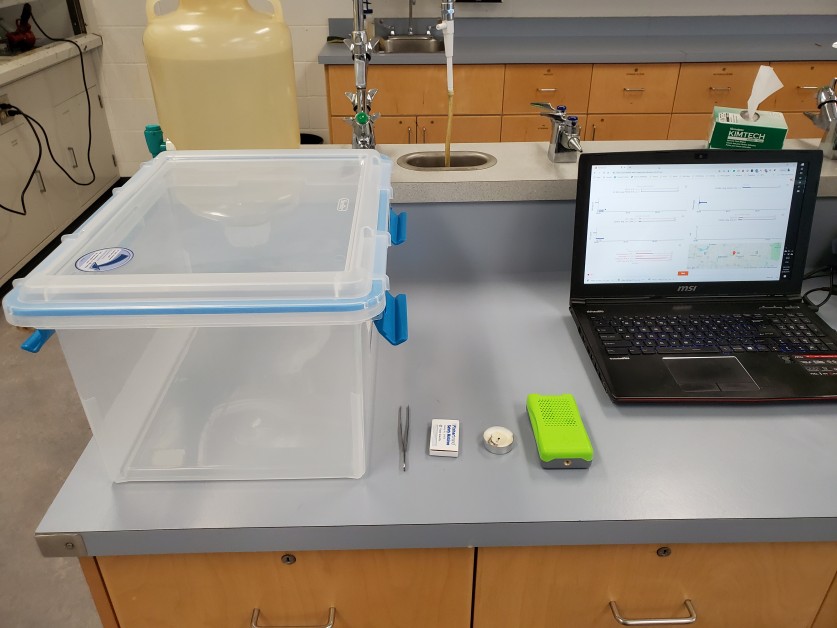Forest fires are a common natural disaster within western North America and pose a serious risk to many communities both nearby due to direct danger of the fire, as well as far away in the form of air pollution. Currently, in many places, some form of government employee will be in charge of looking out for forest fires and once identified, satellites and computer programs can be used to track its progression and predict where the fire will spread and where the smoke cloud will go. This allows us to evacuate individuals who may be in danger and minimize loss of life. However, the individuals looking out for forest fires are normally few and far between, and forest fires are often able to grow quite large before they are noticed. One such method being pursued by the Environmental Protection Agency (EPA) is the use of remote sensors. To promote the development of such sensors, they held the wildland fire sensors challenge. This challenge required a rugged sensor that could be set up in a remote location and measured:
-
Carbon dioxide (CO2)
-
Carbon monoxide (CO)
-
Ozone(O3)
-
Particulate matter (PM)
Table 1. and Reaction 1. below indicate the sources of the EPA’s sensor parameters and their potential health and/or environmental effect.
Table 1. Sources and health/envionmental effects of air pollutants identified by the EPA as being essential to detecting forest fires
Parameter |
Source |
Health/environmental effect |
|
Carbon dioxide |
Combustion of hydrocarbons (plant matter) |
Greenhouse gas |
|
Carbon monoxide |
Incomplete combustion of hydrocarbons |
Toxic; asphyxiant |
|
Ozone |
-formed by Sunlight + nitric oxide + volatile organic compounds -Found in smoke, car exhaust, and industrial pollution |
Respiratory irritant |
|
Particulate matter |
-Microscopic solids and liquids suspended in air -small pieces of burnt plant matter |
Invasive substance; can enter the lungs and even bloodstream |
CH4 + 2O2 → CO2(g) + 2H2O(g)
Reaction 1. The combustion of methane which has the same product as the burning of wood
PocketLab Air as an Early Forest Fire Detection System
While the PocketLab Air does not meet all of the standards of the EPA’s wildland fire sensors challenge it includes many of the sensors required for the early detection of forest fires missing only the carbon monoxide sensor. The sensor on the PocketLab Air are listed below with the bolded indicating they are on the EPA’s wildland fire sensors list and italicized indicating they could be useful in forest fire detection
-
Carbon dioxide
-
Ozone
-
Particulate matter
-
Relative Humidity
-
Temperature
-
Barometric pressure
-
Light intensity
Try testing the PocketLab Air as a forest fire detection system yourself by safely concentrating a small amount of smoke in a small area.
Materials
-
PocketLab Air
-
Sealable container (Sterilite gasket boxes are relatively inexpensive and have an airtight seal)
-
Splint or Candle
-
Match
- Tweezers (If it will be challenging to light things in your container)

Introductory Experiment
Visualizing the components of smoke
-
Get your PocketLab connected to your device and let it run for at least ten minutes to warm up
-
Start collecting data inside the container and wait 5 minutes so you have a baseline
-
Light the candle or splint and then blow it out while it is in the container
-
Quickly close the container
-
Check out what your data says about the air in the container!
-
Open the container and see how quickly the results change
the small amount of flame for a short period involved will cause a negligible change in relative humidity, temperature, and barometric pressure.

Below is a video sped up 10x of the experiment being performed
Example Data
Intermediate Experiment
Testing safe limits for the sensor
-
After performing the introductory experiment, have students hypothesize what change in data would indicate if a fire is present. This could be in the form of a parameter reaching a certain value or a change in a combination of parameters.
-
Perform the introductory experiment a couple of times (perhaps outside of class time), or simply look at the data you have collected previously with students.
-
Have students determine how often their limits would have alerted the user to a fire.
-
Expose them to a situation where their limits may have failed.
-
A person or animal breathing on the sensor would likely exceed a carbon dioxide limit
-
Airborne pollen or dust would likely exceed a particulate matter limit
-
Air pollution from human sources could exceed any or all of the limits especially if there is an industrial accident; this could be considered a benefit as it indicates where air quality is affected which is also useful
-
Advanced Experiment
Designing a forest fire sensor system
-
Have students design, using a standard case or on paper, a system that would allow the PocketLab Air to be used as an early forest fire detection system
-
Test and/or discuss the strengths, weaknesses, and complications of each system that is presented
-
Could test by setting up sensor enclosures around a campfire
-
This can be built onto the intermediate experiment or the discussion at the end of it
-
Possible factors to consider:
-
Airflow
-
Protection from the elements (rain, strong wind)
-
Protection from natural disasters (earthquakes, fire)
-
Protection from animals
-
Access to sensors if they need to be fixed or replaced
-
-
Background Information
Forest fires are both a natural process as well as a natural disaster. Many ecosystems require forest fires for the next generation of plants to grow The most obvious effect is the loss of the old growth which gives plants the space to grow, access to sunlight, as well as allowing them to draw on nutrients from the ash. However, forest fires are even more ingrained into ecosystems than previously thought as many plants will only germinate after a fire has occurred either by sensing heat or due to a chemical trigger from the smoke.(1) However, as we all know, forest fires are a destructive natural disaster which threatens nearby homes, industry, infrastructure, and organisms; luckily due to modern technology, like satellite imaging, people can easily be notified in time to evacuate minimizing the loss of life from forest fires. Unfortunately, forest fires have a broader reach than the flames themselves in the form of air pollution which includes: particulate matter (PM), sulfur dioxide, nitrogen oxides (NOx), ozone, carbon monoxide, and carbon dioxide.(2) Forest fires can be started by human activity or from natural sources such as lightning. While forest fires themselves are not caused by climate change their frequency will be affected by it as extreme weather events become more frequent, and the climate becomes warmer and dryer in effect lengthening forest fire season. This could act as a positive feedback loop as climate change increasing the frequency of forest fires would lead to the loss of the forests ecosystem services including the storage of carbon which is the carbon dioxide in the smoke.
Particulate Matter
Particulate matter is made up of solid and liquid aerosols, and it is categorized by diameters of 10 µm and less, 2.5 µm and less, and 1 µm and less (PM10, PM2.5, and PM1 respectively). PM10 is small enough to enter the lungs, while PM2.5 is small enough to enter the bloodstream. Beyond the penetrating size of PM, the species that make it up or the molecules that collect on their surface can have their own health hazards making even small PM concentrations potentially dangerous.(3) Common species found among particulate matter include sulfate, nitrate, ammonia, sodium chloride, black carbon, minerals, dust, and water vapour.(4)
Sulfur Dioxide
Sulfur dioxide is a minor factor as it is produced in small amounts unless the fire involves peat or musk soil.(2) While it is a respiratory irritant, its unpleasant smell and possibility to form acid rain is often a bigger concern.
Nitrogen Oxides
The production of nitrogen oxides requires higher temperatures than most forest fires reach.2 However, if produced it can lead to acid rain.
Ozone
Although stratospheric ozone protects us from the sun’s ultraviolet (UV) radiation, Tropospheric ozone is a severe respiratory irritant. Tropospheric ozone can cause lung disease and increases the morbidity and mortality rates of asthmatics.(4)
Carbon Monoxide
Carbon monoxide is a severe health concern as it binds preferentially and irreversibly to human red blood cells causing asphyxiation at high enough concentrations.
Carbon Dioxide
Carbon dioxide, along with water vapour, is what allows us to live within a comfortable temperature range through the greenhouse effect. However, when carbon dioxide levels increase so does the greenhouse effect which causes more warming. The carbon stored in wood as organic compounds when burned forms carbon dioxide. A single forest fire is not a large enough source to have major effects, as carbon dioxide is involved in many natural cycles and has significant sinks(natural places that it is stored). However, all the natural and human sources added together are significant enough that we are seeing carbon dioxide levels rise globally and along with the average global temperature as well; this is climate change. The current ambient concentration of carbon dioxide is 410 ppm and it was just below 320 ppm in the 1960s which is the most rapid change seen in Earth’s history.
References
1. Mahaffy, P. G.; Bucat, B.; Tasker, R.; Kotz, J.; Treichel, P.; Weaver, G.; McMurry, J. Chemistry : human activity, chemical reactivity; Nelson Education: Toronto, 2011; .
2. AirGo natural causes of air pollution: Forest Fire. https://www.airgo2.com/air-pollution/causes/natural/forest-fire/ (accessed May 23, 2019).
3. Rogulski, M. Using Low-Cost PM Monitors to Detect Local Changes of Air Quality. Polish Journal of Environmental Studies 2018, 27, 1699-1705.
4. World Health Organization Ambient (outdoor) air quality and health. http://www.who.int/mediacentre/factsheets/fs313/en/ (accessed May 24, 2016).


